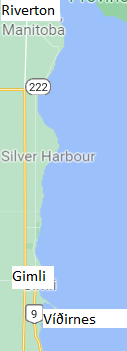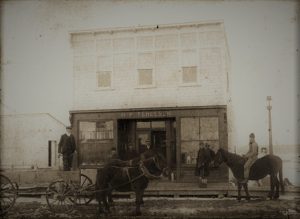
Gimli in the wrong place?
When the first group went down the Red River in the autumn of 1875 on their way to New Iceland, the settlers discussed various issues concerning the new Icelandic settlement. Jón Jónsson from Munkaþverá in Eyjafjörður was in the group and wrote: “One of the things that was talked about among those who wanted to discuss serious issues was the name of a prospective settlement and town, and the name New Iceland was approved, although it had been discussed before. Names were suggested for a town, Ólafur Ólafsson from Espihóll came up with the name Gimli, and received a unanimous recommendation, so from then on it was considered certain that the town would be named that way. But it should stand by the Icelandic River (Íslendingafljót). ” (Framhald á Landnámssögu Nýja Íslands, pp. 35-36). In July of the same year, a special survey committee had gone down the Red River, out to Lake Winnipeg and sailed north along the coast until it reached the mouth of the river. There they rowed up the river and inspected the land, and the committee members liked it. Icelandic settlement was to begin here in the autumn. The first group of settlers set off on the same route from Winnipeg. Jón frá Munkaþverá described this as follows: “Up from the Red River, on the way from Winnipeg to New Iceland, our barges were getting stuck on rocks and beached in the shallows, and it soon became clear who was the best at finding the correct way through; one could mention the young men who had gone this way before (the land tour with Taylor) …. The steamboat “Colville” pulled the barges from the Red River out to the lake and north to the point at Víðirnes and left them there, more than a mile from land. The captain did not seem to know if the depth was sufficient for the ship to go closer to shore. So the rowing boat we had, an eight-oared called a York boat, was manned, and it was used to pull the barges which were tied together and probably about 300 feet long and extremely difficult to pull. But luckily, the weather was calm, otherwise a rowboat would not have been able to do anything. It was rowed south of the point, into the cove, and landed where the beach is narrow. ” (Same source p. 36) Captain Colville offered to tow the barges north to the river mouth, but winter came unexpectedly on the first day, dark, heavy clouds appeared over the lake to the north, it cooled down. He gave the settlers two options: on the one hand, to pull the barges back to the Red River or stay as close to land where the fleet had arrived. The settlers chose the latter option and came ashore with their belongings. During the night the water froze and it snowed. The next day, people moved luggage and supplies to the place that is now Gimli.
The town rises:
By the end of 1875, the settlers had built several houses that were the first sign of a village. Gradually, the number of houses increased throughout the decade, but around 1878 emigration from New Iceland began. People sought more fertile lands, moving south to N. Dakota or to the south and west in Manitoba. Those who did not want to give up on the difficulties in New Iceland moved from Gimli north to the Icelandic River (Íslendingafljót) where another village, Lundur, had formed. Gimli stood almost like a ghost town from 1880, but it was not for long. New groups from Iceland came to Winnipeg, Manitoba and many of those newcomers went to New Iceland and settled in Gimli or the Víðirnes Settlement around the village. Manitoba’s borders were moved north in 1881, making New Iceland part of the province geographically. The settlement, however, continued its uniqueness, its laws from 1877 remained in force. Newcomers from Iceland benefited from the experience of those who had persevered in the area, but they also had many useful things to offer. As the decade progressed and almost all of the land around Gimli was settled it was important that service to the settlers was good. All transportation was difficult both within and to the settlement. Products were transported from Selkirk by boat to Gimli and north to Icelandic River. A road through the settlement was built in 1876-1877 and was no wider than two travelers could meet with their wagons. The road was widened in 1893. In 1887, the settlers decided to become fully part of Manitoba, and the laws and regulations of the province were adopted and the old laws were abolished.
Schools: The leaders of the pioneer settlements immediately realized that they were shaping a new, Icelandic society. John Taylor, one of the leaders of the settlement, wrote a letter to the provincial authorities on October 30, 1875, saying that Icelanders wanted to run a school connected to the Manitoba education system. He then said he was ready to build a schoolhouse, and a teacher had come west with them. A formal letter of appeal to the Canadian authorities was sent from Gimli on January 10, 1876. A reply was received from the Minister of the Northwest Territory, as the settlement belonged to that part of the country during these years. The letter was dated March 8, 1876 and was addressed to the Manitoba authorities. The subject of the letter was a simple reminder: The Canadian government is not involved in educating any children in the Northwest except the Indians. The residents of Gimli probably knew their position in school matters because they did not wait for an answer from the ministries but started teaching in Gimli immediately in the autumn of 1875 and the students numbered between 20-30 when the attendance was taken close to Christmas. Among the students were a few adults because the teacher, Caroline Taylor, John Taylor’s daughter, was in charge of teaching, and she emphasized learning English. It was considered so successful that at the turn of the year it was decided to teach until spring. The smallpox outbreak that afflicted the settlers in the autumn of 1876 prevented school from resuming at Gimli, but as soon as doctors gave the green light, the school was re-opened. The teaching took place in the warehouse, which had been built around the stock brought by the pioneers in the autumn of 1875. Jane Taylor, another daughter of John Taylor, now took over the teaching, as 63 students of different ages were registered. Emphasis was placed on learning English, both spoken and written. Jane then taught the students to sing in English. New Iceland had been established in this place, for Icelanders, outside of Canadian society, where Icelandic heritage was to be preserved and Icelandic to be both spoken and written. The leaders of the colony encouraged home teaching in Icelandic and this advice was followed by all parents. It is clear, however, that with such a strong emphasis on English learning, everyone was aware of the need to master some English, as of course there was a need to communicate with English-speaking Canadians. In the winter of 1877-78, the school was enlarged and Lára Guðjónsen, the wife of Reverend Jón Bjarnason, now took over the teaching. It was taught five days a week with an emphasis on reading, arithmetic, geography, singing and Christianity. Furthermore, English was still taught. Tuition was free, Lára probably volunteered her work. She did not teach for long however, as she and her husband returned to Iceland in 1880. In 1887, March 15, the first meeting of the newly formed local government of New Iceland was held in the Árnes Settlement and the merger issue, i.e., that New Iceland would be in one and all part of Manitoba, was the main issue of the meeting. Another issue was the school system of the settlement and the question of whether it would also be one and all unified school system of the province. The residents of Gimli did not agree on the school issue, any more than the other residents of New Iceland. Two points of view were addressed: On the one hand, private schools in the settlement to be run by Icelanders with Icelandic emphases. English could be taught extra. On the other hand, the settlement schools would be part of Manitoba’s education system in one and all, all teaching would be in English. Undoubtedly, the most important thing for the majority of the population is that schools and education would be completely free of charge if an agreement with the Manitoba education system were approved. Icelandic private schools, on the other hand, would be entirely financed by the locals. The unification took place and after 1889, there was little to no mention of a private school. In the same year, five new schools were built in the settlement and another two years later.
Post Office: Icelandic settlers in the West, wherever they lived, always placed great emphasis on postal services. One of the first things they considered in any new settlement on the plains in Canada, or in the United States, was getting permission to open a post office. Usually one of the settlers offered to provide the service and a post office was opened in the person’s house. The post offices were often given a name, very often Icelandic, but they also bore the names of villages or towns. The post office was the address of every settler in that settlement. People wrote the name of the post office at the top of the letter and that’s where the mail was delivered to. In the early days, it was not uncommon for the post office to change names. One explanation for the name changes of immigrants was the mail, because there were often several common names in each area. It could then take a long time to get a letter in the right hands because it was often a long way from settler’s homes to the post office and there were no roads, or they were often impassable either due to wet weather or snow. The Gimli post office served the whole of New Iceland at the beginning, and it is obvious that it was a long way from there to the northernmost parts of the settlement. Páll Jóhannsson took care of mail delivery from Lundur, where Framfari was printed, by way of the Icelandic River to Gimli. One day it took him almost five hours to transport the paper from the printer, almost fifty kilometers (31 miles) to Gimli. It was considered a great achievement, but he took advantage of the ice on the lake and skated part of the way. The person writing this (JÞ) worked during his studies with a professor at the University of Manitoba on a project that researched postal services in Manitoba from the founding of the province until the turn of the century. He found it interesting to see how high a proportion of Icelanders received and sent mail. People sent letters to friends and family all over the continent and of course back to Iceland. The letters that reached Gimli were from relatives and friends in Manitoba, Ontario, Nova Scotia, Minnesota, North Dakota, even Brazil, but most of the mail often came from home.

The Tergesen’s store in the early 20th century. The store opened in 1889. Photo: Prairie Towns.
Improved transportation: Winnipeg residents were overjoyed when a railroad company decided in 1902 to build a railroad along Lake Winnipeg to a beautiful beach they named Winnipeg Beach. There was to be a summer resort and an amusement park for the townspeople. Cottages were built and all kinds of rides, activities, and beaches were built. A hotel was built along the main street and the number of visitors increased every year. In 1913, there were 13 trains running throughout the summer between the city and Winnipeg Beach. It was inevitable that the Icelanders in Gimli saw various opportunities with the introduction of the railway to Winnipeg Beach as there are only about 15 km (9 miles) between the beach and Gimli. In 1900, a pier was built at Gimli, which meant that larger ships could now sail to Gimli, so that all services in the town improved greatly. People did not stop there, but locals started talks with the railroad company that had laid the railroad to Winnipeg Beach. The railroad company welcomed the idea and in 1906, Gimli was connected to the powerful railway system.
English version by Thor Group.

Tergesen’s store in Gimli today
